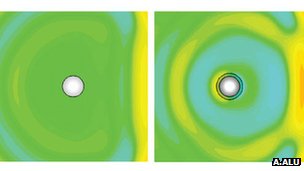Did you envy Harry Potter upon reading the chapter in The Sorcerer’s Stone where he was given the invisibility cloak? BBC News reported that a new broadband invisibility cloak has been developed that conceals objects at certain microwaves or wavelengths of light. According to US physicists, such cloaks highlight objects, making the subjects more prominent, rather than concealing them at other unsuitable frequencies. For making something transparent from every angle over vast bandwidths, Andrea Alu from the University of Texas states that this newly developed cloak will work when principles of the electromagnetic spectrum are taken into consideration. Alu and company are working on developing a cloak that will successfully conceal, being an ultimate escape cape in the making.
The first model of a realistic invisibility cloak premiered in 2006 as a study of “transformation optics” by teams at Imperial College in London and Duke University. This design had many limitations to its use, since it only worked with certain substances. The initial design was diamond-shaped, manipulating light around the cloak, bending microwaves around a copper cylinder to conceal objects. The prototype was constructed from a thin shell of metamaterials, which lacked some crucial components. This is because these materials contain artificial composites that have unnatural properties that do not normally occur.

Image via Andrea Alu: Right — cloaked image that scatters more radiation. Left– bare image
Currently, the designs that have been produced have encountered difficulty within limited bandwidths. There have been some issues in achieving the “perfect” 3D structure that camouflages objects from microwaves.
As developed in a new study in Physical Review X, Prof. Alu’s team studied a plasmonic cloak, a mantle cloak, and a transformation-optics cloak; these three cloak prototypes can stand alone without electricity. When all were tested throughout the entire range of the electromagnetic spectrum, Prof. Alu’s team discovered that the cloaks scattered more waves than the item it was trying to cover.
If you apply coverage in one range, then a discrepancy arises in another end of the spectrum. In an interview with BBC News, Alu explained that “you might make a cloak that makes an object invisible to red light. But if you were illuminated by white light (containing all colours) you would actually look bright blue, and therefore stand out more.” The study determined that a cloak that provides complete coverage is impossible with the designs that were currently developed.

Image via Computer World
Alu stated that “when you add material around an object to cloak it, you can't avoid the fact that you are adding matter, and that this matter still responds to electromagnetic waves.” A technology that could solve this problem is a more active form of cloaking. This design uses electrical power to essentially make objects disappear into thin air, just like in the mystical land of Harry Potter. The active cloaks are much thinner than passive cloaks, and actually disguise.
The design that Alu has invented uses amplifiers that wrap the surface of the object with an electrical current, allowing the cloak to mask the object from detection.
There are many practical benefits to integrating invisibility cloaks into our daily lives. A radio-frequency cloak would be beneficial for wireless communications. Little interference from antennas would occur, since objects would be bypassed.
Alu's team will continue to tweak the design of the cloak, and work with other innovators to construct a perfect model.
Story via BBC News
Advertisement
Learn more about Electronic Products Magazine





